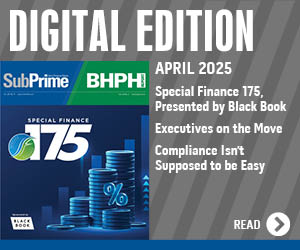Dealers still see subprime availability as big players adjust

The size of the U.S. subprime population is getting smaller — at least that’s what FICO says. And large finance companies such as General Motors Financial again acknowledged that the segment of its portfolio composed of subprime paper will continue to diminish, too.
However, dealerships that participated in KeyBanc Capital Markets’ monthly survey indicated that they’re still able to obtain financing for their vehicle buyers, even if they fall into the subprime credit tier.
In fact, KeyBanc reported that 100 percent of respondents who participated in the May survey said financing availability remained intact or is even increasing.
“Commentary from the field is that larger players are pulling back on subprime as smaller financing companies are becoming more aggressive and gaining share,” KeyBanc said in its latest survey recap shared with SubPrime Auto Finance News.
“The commentary from the larger lenders, such as Santander, suggests they will not be chasing market share,” KeyBanc continued. “So in the end, who is lending to the subprime consumer is changing, but the auto industry continues to have access to financing.”
Santander Consumer USA shared its stance about subprime volume not only when it announced its first-quarter results back in April, but also when chief executive officer Jason Kulas reiterated the position during the Morgan Stanley U.S. Financials Conference in New York earlier this month.
“We are only concerned about volume to the extent that we want to make sure we get volume that will be profitable through cycles — volume that has the right price and the right structure, the right return,” Kulas said.
Meanwhile, GM Financial noted its stance again last week when chief financial officer Chris Choate hosted a presentation titled “Behind the Charts” in which he touched on several elements of the finance company’s business operations. When it came time for Choate to answer questions from Wall Street observers, multiple analysts wanted to know about GM Financial’s plans for subprime originations.
“We at GM Financial have sort of, particularly in the used-vehicle financing space, we have allowed our market share in that space to erode dramatically. We still have a presence, but it’s way down from what it was,” said Choate, who referenced a portion of his presentation that highlighted how GM Financial’s subprime business outperformed the track of the Wells Fargo Subprime Auto Index going back nearly six years.
“If you go back over a two- or three-year time period, our presence in that used-vehicle financing space as the market got a little frothier and really became too narrowly priced … we just kind of have sidled off to the sideline a bit,” he continued. “So we think that’s certainly one of the reasons why we’re outperforming this index that we showed in the chart is we’ve just maintained a lot of pricing and credit discipline.
“And that's not to necessarily say that others didn’t,” Choate went on to say. “A lot of the newer entrants in the space — and they do end up in the industry part of this index that we showed — target a different level of subprime. So subprime is big; it’s a word that covers a fairly broad swath of territory, generally from 620 FICO all the way down south of a 500 FICO. And so you have some of the newer entrants that necessarily have to grab onto the credit scale down lower in order to get a toehold and have a viable value proposition to dealers. So it’s not all apples and apples, quite frankly.”
Choate continued his response alluding to trends that KeyBanc referenced in its latest dealer survey: whether or not finance companies might be pulling back in how much subprime paper they’re originating. Choate insisted “it’s a little more complex than kind of a blanket observation there,” as to whether or not the majority of the industry is deciding to take its foot off the subprime pedal.
“If you look at the market data kind of month by month by month by month, there are any number of smaller and larger players that mash on the gas and then pull back,” he said. “It kind of ebbs and flows a decent amount, and that includes Santander and (Capital One) and Wells Fargo and Chase Auto Finance and us and Ally (Financial) and all the others, not just the small guys, who will express through their buying habits a little more desire for a certain credit tier or a credit mix in one month or two.
“And then for whatever reason sort of pull back on that a little bit two or three or four months down the road,” Choate continued.
Then the GM Financial executive took the view of a dealer, “be it CarMax or somebody else.” Choate acknowledged, “You can certainly develop a view that the market has tightened just because one of your primary lenders may have ebbed versus flowed over a certain period of time.
“We certainly don't view at GM Financial that there's going to become a lack of credit availability in subprime,” Choate declared. “It’s certainly possible, and I think we would stay hopeful that pricing will firm a bit in subprime in order to fatten the margins back up a bit.
“But I don't believe that you're going to see any dramatic tightening,” he went on to say. “I think generally credit appetite at least across the larger, more established players of which we and the others I rattled off are those guys, we think it will be fairly stable.”
While FICO indicated the total subprime population dropped to the lowest point in about 10 years when analysts compiled their April data, Choate described the kind of subprime customer GM Financial will book a contract with nowadays.
“The demographic of a subprime borrower today for us is generally better than what a subprime borrower looked like for us 10 years ago. They have better household income, a little more stability on residence, a little more down payment going into the deal,” Choate said. “So we have a better through-the-door subprime consumer now than we did 10 years ago.”


